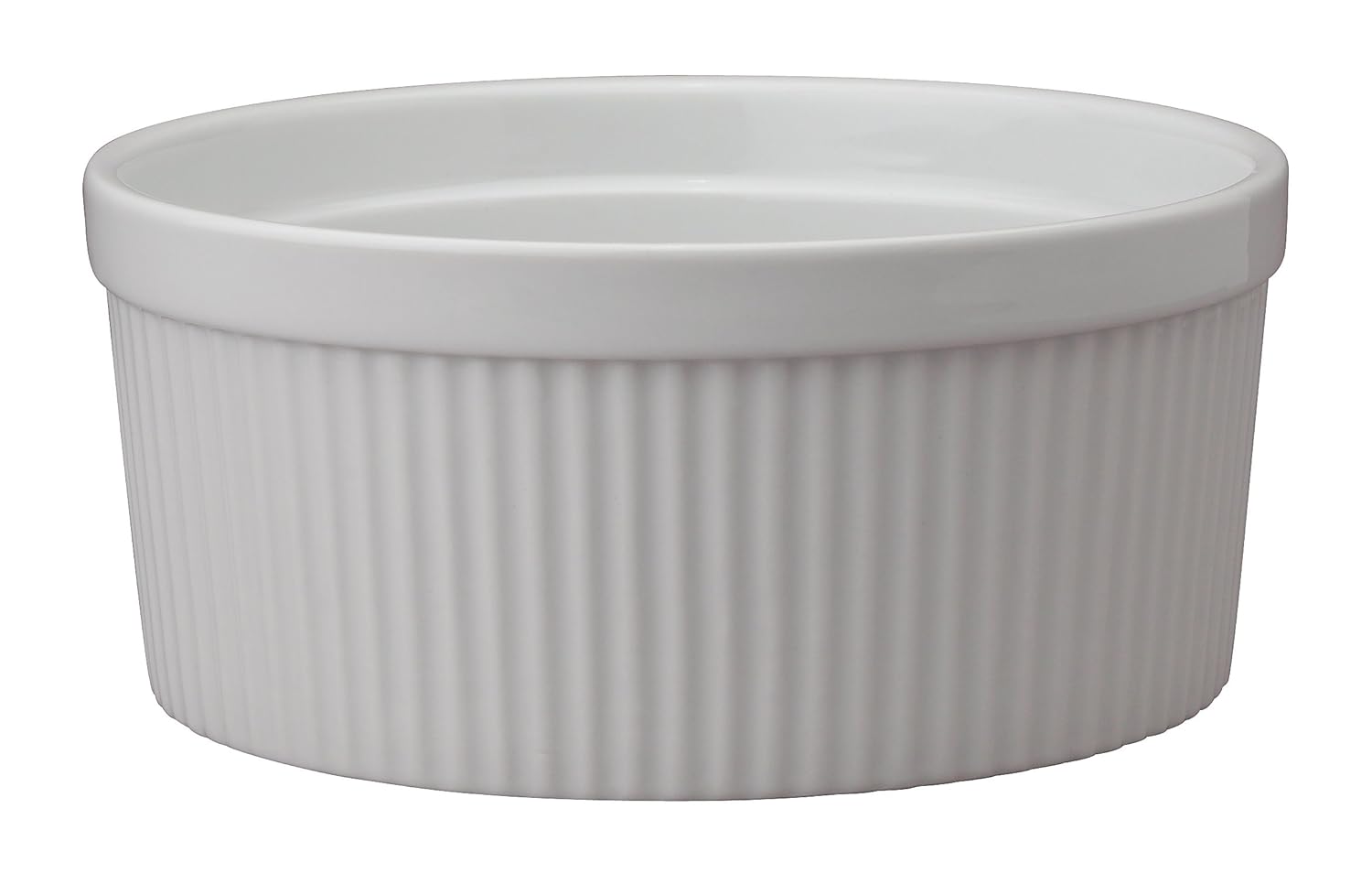
Silky smooth, sweet, rich custards are a sensual way to end a nice meal without being too heavy. Dessert custards all share something in common: a glossy, silken texture and lavish flavor. The difference between crème brûlée and flan (two of our favorite kinds of custard) lies in four factors: the ratio of ingredients, the manner in which the custard is thickened, the method of cooking, and any additional components. Those extra components—different toppings and presentation—are easiest to see.
Bellemain Porcelain Ramekins, 6 for $12.95 on Amazon
Both desserts are commonly served in dainty ramekins for individual portions.
The Balance of Eggs, Sugar, and Dairy
In custards, the proportion of eggs to sugar to dairy is critical, since texture and flavor hang in delicate balance. Eggs lend sturdiness, and the most opulent custard desserts contain only egg yolks. Sugar also affects texture: The more sugar in a custard, the less firm it will tend to be, and the longer it will take to set. And the amount of fat in your dairy, whether cream or milk, will affect the dessert’s level of richness.
Which Thickening Agent?
Custard is set in one of three different ways: with eggs, starch, or gelatin. Crème brûlée, pots de crème, and flan are thickened with egg; in contrast, pastry cream and American-style cheesecake often employ cornstarch or flour. Gelatin is used to add a gel-like consistency to Bavarian cream and most mousse recipes.

Chowhound
Cooking and Serving Method
All custards are set using low, gentle heat. However, they fall into one of two categories: stirred (cooked on the stovetop) or baked (set in a water bath in the oven). Crème anglaise, pastry cream, mousse, and pudding are stirred; flan, crème brûlée, and pots de crème are baked. Custards can also be served at a wide range of temperatures: Serve crème anglaise warm, and it’s a sauce; freeze it and it becomes ice cream (and vice versa).
Additional Components
More elaborate custard desserts involve additional components, such as toppings or coatings. Crème brûlée contains a layer of hard caramel on top, achieved by melting sugar with a blowtorch; crème caramel is coated in a layer of soft caramel before being turned out.
Harold Import Co. White Porcelain Souffle Dish, $18.99 on Amazon
Flan is often made in a souffle dish, which is basically just one big ramekin!
When it comes to crème brûlée and flan, it’s mostly the toppings that distinguishes the two, as well as the presentation. The former has that signature crackly sugar crust on top, and the latter has the gooey, soft caramel top. Crème brûlée is served within mini soufflé dishes, and flan is served out of the dish, standing alone. And it’s also the culture each dessert hails from: French and Latin American cuisines.
Try your hand at one or the other, or both, and don’t forget your spoon!
Crème Brûlée

Chowhound
The classic baked custard made with sugar and thickened with egg yolks and cream is famously topped with sugar that’s torched or broiled to form a hard caramel crust. This basic crème brûlée just uses light and heavy creams, sugar, vanilla, and yolks. Get our Crème Brûlée recipe.
Tintec Culinary Blow Torch, $13.47 on Amazon
This refillable butane torch (with safety lock) is a great, safe way to play with fire in the kitchen.
Coconut Flan

Chowhound
Flan (also known as crème caramel) is a custard of sugar, milk, cream, and egg yolks, baked in a caramel-sauce-lined ramekin until soft and wiggly. Our coconut flan has rum, coconut cream, and Get our Coconut Flan recipe.
Eggnog Crème Brûlée

Chowhound
Buy some eggnog (or make it yourself if you can’t find any) and add some nutmeg and you’ve got a winter holiday-style sweet custard with the glorious crackly crust. Get our Eggnog Crème Brûlée recipe.
Microwave Crème Brûlée
It won’t look as pretty, but with a microwave and a toaster oven, you can make this delicate dessert (which is certainly fancier than a mug cake). No need for a blow torch if you don’t have or want one. You can broil the sugar on top of the custard to get that hardened sugary layer that defines this dessert. Get our Microwave Crème Brûlée recipe.
Pumpkin Pie Flan

Chowhound
Pumpkin purée, graham crackers, cinnamon, sour cream, and all-spice flavor this flan. It’s the best of both worlds. Get our Pumpkin Pie Flan recipe.
Other Dessert Custards: A Cheat Sheet
Crème anglaise is a stirred custard made with milk, sugar, and eggs (or sometimes gelatin).
American-style pudding is often made with cream and milk, sugar, gelatin, and a starch thickener such as cornstarch. It sometimes contains no eggs. Get our Easy Vanilla Pudding recipe.
Mousse is a stirred custard made with sugar, eggs, and gelatin; it’s lightened with the addition of egg whites and whipped cream. Get our Basic Chocolate Mousse recipe—and see the specific differences between mousse and pudding.
Pastry cream is a stirred custard made with milk, sugar, and egg yolks, and a large amount of thickener such as flour or cornstarch. Get our Strawberry Tart with Citrus Pastry Cream recipe.
Pot de crème is a loosely set baked custard composed of cream, sugar, and egg yolks. Get our Chocolate Pots de Crème recipe.
Cheesecake is a baked custard made with sugar, eggs, and cream cheese, and often made firmer with the addition of flour. Get our Nutella Chocolate Cheesecake recipe—and see more about all the different types of cheesecake.
If you want even more recipe ideas than the suggestions above, check out our many custard recipes and dessert recipes.
All featured products are curated independently by our editors. When you buy something through our retail links, we may receive a commission. For more great hand-picked products, check out the Chowhound Shop.
— Susannah Chen’s Dec. 13, 2014 article was updated by Amy Sowder on Feb. 8, 2017 and by Jen Wheeler on Feb. 12, 2019.
from Food News – Chowhound http://bit.ly/2Dvo7jW
via IFTTT




No comments:
Post a Comment